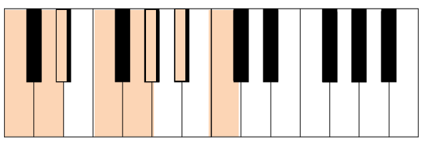A scale is an ordered sequence of notes. For example: do, re, mi, fa, sol, la, ti, do… repeating this cycle. On this scale, we start with the do note and follow a well-defined sequence of intervals until the return to the do note again.
This sequence of distances was: tone, tone, semitone, tone, tone, tone, semitone… repeating the cycle. This scale is called the “major scale“. We could use this same sequence (major scale) starting from a note that was not C, but for example: G. The scale would then be: sol, la, ti, do, re, mi, fa#, sol…
Notice how the same logic was followed (tone, tone, semitone, tone, tone, tone, semitone). In the first case, we form the major scale of C. In the second case, the major scale of G.
Following the same logic, we can build the major scale of all the 12 notes we know. Do this as an exercise and then check it out below. We will show you the major scale of the 7 basic notes:

For other scales, we have other sequences to be followed (other intervals). The one called “minor scale“, for example, is formed from the following sequence: tone, semitone, tone, tone, semitone, tone, tone… repeating the cycle.
So, let’s build the C minor scale. You are already able to build that scale. Just follow this sequence starting with the C note. It goes like this: do, re, re#, fa, sol, sol#, la#, do … repeating the cycle.
The notes re#, sol# and la# are equivalent, respectively, to mib, lab and tib. We could then rewrite the above sequence as: do, re, mib, fa, sol, lab, tib, do.
Note that the scale is absolutely the same; the only difference is that before it was written with sharps (#), and now it was written with the flats (b).
Usually the minor scale of C is written in the second way and not the first. Why? Simply because all 7 notes appeared in it (with or without alterations – sharp/flats). In the first case, the notes E and B do not appear.
Does that change anything? It does not. But in literature you will probably find the second description, for the reason mentioned. Actually, the preference for the second description has a deeper meaning, as it facilitates the observation of harmonic functions, but don’t worry about that now.
Check the sheet music and tablature of the major scale and the minor scale:
C major scale

Note: if you are a keyboardist/pianist and have not learned the sheet music yet, check the shapes on the keyboard below:

C minor scale


Note: On the fretboard, to obtain the scale of another note (in addition to the “C” note that we show), just move this same shape to the desired note. Try this out by making this same shape of the C major scale starting from the D note. Then check the generated notes against the table shown earlier. That’s great, isn’t it? It means that we only need to memorize one shape for each scale! On the keyboard, we don’t have that privilege. However, the keyboard has numerous other facilitating advantages. Each instrument has its pros and cons!
Natural Scales
Okay, back to the subject, you may be wondering why one scale is called “major” and the other “minor”.
This is just a definition. The difference of these scales is in the third, sixth and seventh degrees. On the “major” scale, these degrees are major. On the “minor” scale, these degrees are minor. That is why it was decided to call the first scale “major scale” and the second “minor scale”. As there are other types of major and minor scales, these basic scales that we just saw are called “natural scales“, as they are the most basic and primitive in music study. In the next articles you will understand the subject of degrees well, so don’t worry if you found these terms strange.
The “natural major” and the “natural minor” scales are also called major diatonic scale and minor diatonic scale. The name “diatonic” means “to move by the tonic”. Whenever we use the term “diatonic” or “diatonic note”, we are saying that this note belongs to the natural tonality (or natural key); that is, the note is part of a major or minor natural scale.
Other music scales
There are several other scales, as we will see in other topics. But the essence is always the same. There is a defined sequence of tones and semitones, and from there, the scale is created starting from the desired note. It’s that simple.
Ok, everything’s great and fine, but what is each scale for? Where are they used for?! Now that’s the question, my friend! Nobody answers that. You will find texts in books and on the internet showing different scales, but it’s rare to find an explanation about where to apply each one.
Fortunately, you are in the right place! We organized all the contents in our website so you can have all the basis necessary to take this subject to the next level. We will talk about each scale specifically showing how to apply them and everything. These secrets are not revealed like this anywhere, but here in Simplifying Music you will learn everything you need.
In fact, even if you pay for expensive material out there, you would hardly find any quality material on this topic. That’s a fact. It is no wonder that only a few musicians truly know music theory. Our material was built to break that barrier.
Go to: Module 2
Back to: Simplifying Theory
